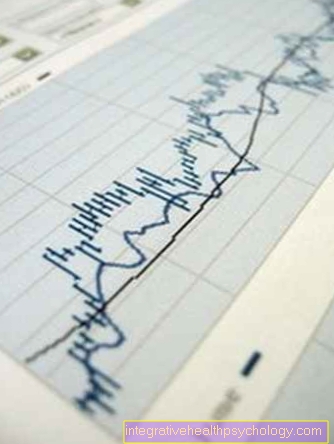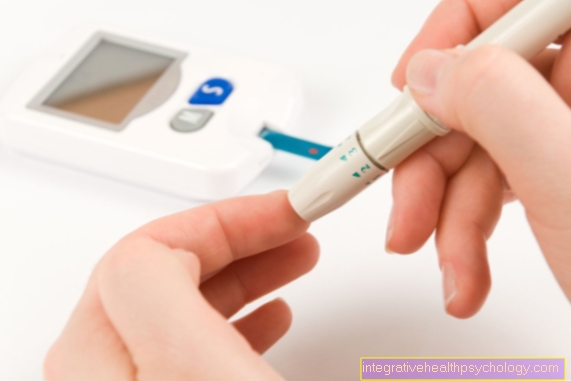Anaerobic threshold
introduction
Sports performance always requires the provision of energy (ATP). The anaerobic threshold marks the point at which the body can no longer cover its energy production from the oxygen transport through the blood. This is the case at the beginning of athletic performance, as well as with higher loads.
If the anaerobic threshold is exceeded, energy is generated from the anaerobic-lactic metabolism. Please refer 2. under energy generation.
The anaerobic threshold plays a particularly important role in competitive sports, as this is the point where you can train particularly effectively. The anaerobic threshold is also a performance parameter that can be determined using the lactate curve. However, this performance assessment reached its limits (see below).

Anaerobic threshold than lactate threshold
The anaerobic threshold can be determined not only from the energy gain without oxygen, but also from the accumulated lactate. At the anaerobic threshold there is one maximum lactate steady state (maxlass). This means that the accumulation and elimination of lactate are in maximum equilibrium. Every increase in exposure leads to an exponential increase in lactate levels.
Energy generation
When generating energy are the human body four different options are available.
- 1. anaerobic alactic acid: In this form of energy production, creatine phosphates (KrP) are split. The energy is available immediately, but is used up quickly (sprint).
- 2. anaerobic lactic acid: Here, carbohydrates (glucose) are used in glycolysis without consuming oxygen. Lactate is produced, which means that the muscle becomes overly acidic. This form of energy generation is a priority for maximum runs in the 400-800 meter range.
- 3. aerobic glycolytic: Here, carbohydrates (sugar) are used in glycolysis with the consumption of oxygen. This is the case with rapid endurance runs.
- 4. aerobic lypolytic: During this energy production, free fatty acids are oxidized with the consumption of oxygen. Especially with slow continuous running.
Individual anaerobic threshold

It was MADER et al. 1976, the first the anaerobic threshold with a fixed value of 4 mmolL / L fixed. However, this is only a guideline that cannot be applied to all athletes. Every athlete has an individual anaerobic threshold. To determine this threshold, sports scientists have published numerous publications over the past few decades. See lactate threshold conceptions.
Limits of the threshold concept
Through different Threshold concepts, different lactate values also come about at the anaerobic threshold. So far, no threshold concept has been scientifically proven and no concept is therefore not valid. Conclusions about the performance of individual athletes are therefore not really given.
Physiological influences on the anaerobic threshold
The anaerobic thresholdand the lactate curve are subject to numerous intra-individual fluctuations. The anaerobic threshold depends on the form and time of day. These should always be taken into account in a lactate test.
Furthermore, the diet plays a decisive role in the development of Lactate. Lactate is formed through the synthesis of carbohydrates. If these are not available, less lactate is produced. This would speak for improved performance, but it is not correct.
The previous exposure is also a decisive criterion for the formation of lactate. There should be no stress beforehand on the test day. The day before a lactate test only with light exercise.
Pulse
The increased pulse - when is a pulse considered too high?Pulse or also the Heart rate can be calculated with different formulas. A formula that calculates the maximum heart rate or the maximum pulse very easily, but leaves out the individual component is the formula: "180 minus age"Or"220 minus age, of which 70 percent". A more complicated formula, but it is more precise CARVON formula. For this you need the Resting heart rate, the Maixmalpulse and the Training factor. Extensive Endurance training is calculated with 0.6 (60%) and intensive endurance training with 0.8 (80%). The formula is: "maximum heart rate - resting pulse * factor + resting pulse“.
The pulse rate at the anaerobic threshold is approx. 85 to 95 percent its maximum value. In this zone, the inhaled oxygen is no longer sufficient to burn the required energy in the body and the muscle begins to become over-acidic. The pulse rate at the anaerobic threshold is highly individual and also depends on the fitness level and the type of sport. For example, runners use more muscles than cyclists and therefore have a slightly higher heart rate in the anaerobic area. If you get into the anaerobic area during a training session, you can see this in the Heart rate or exercise curvewhich then has a kink. This means that the heart rate can no longer rise to the same extent as the performance. The pulse curve shows what is known as a flattening.
For example, the pulse around the anaerobic threshold can be estimated at 174 beats. Training will not reduce the pulse rate at the anaerobic threshold, but the body will work more economically over time, you get faster with the same pulse rate.
Lactate

Everyone has one in peace Lactate concentration from 1 to 1.8 mmol / l im blood on. This basic value comes about through constant organ and muscle activity. If the strain on the body increases, more muscles are activated and the lactate concentration rises to between 2 and 4 mmol / l lactate in the blood. this is the aerobic-anaerobic transition area. The higher the load, the more difficult it is for the body to provide oxygen-based energy. The body gets into a Oxygen deficit and the energy will be on anaerobic-lactic route provided. Lactate is produced in the muscles and released into the bloodstream. The anaerobic threshold is approx. 4 mmol / l and shows an athlete's ability to postpone and postpone the rise in lactate levels in the body for as long as possible. If the load is higher, the lactate value continues to rise and the lactate concentration continues to rise. The body is no longer able to break down the lactate faster than it is accumulated. At the anaerobic threshold, as with the pulse, you can also see one in the lactate curve Kink. From then on, the lactate value increases very sharply in proportion to the load. The anaerobic threshold is therefore also called upper limit for a lactate balance designated. This condition will too steady-state called, where the oxygen uptake is no longer sufficient to cover the entire energy requirement.
Studies and investigations have shown that the anaerobic threshold can also be determined from the lactate concentration and a breath gas analysis. Due to the higher lactate production above the anaerobic threshold, the composition of the energy production changes and thus also the composition of the breathing gases that are exhaled. For this reason, the anaerobic threshold is also known as the lactate threshold, since at this threshold accumulation and degradation are no longer in balance.Since this lactate threshold is not the same for everyone, but depends on your constitution, diet and fitness level, it is also called an IANS, individual anaerobic threshold. So one should not start from 4 mmol / l for the lactate threshold / anaerobic threshold, but rather set the value between 2.5 and 4.2 mmol / l depending on the condition. You can also change the threshold through exercise and diet.
Determine lactate value
In order to create an effective training plan, you should know your anaerobic threshold or lactate threshold or determine it beforehand. The anaerobic threshold can only be determined through measurements. With Lactate tests, Ergospirometry and other methods, this threshold can be determined. The anaerobic threshold can be reduced by a step-by-step stress test together with blood samples. A variant of this determination is CONCONI testwho is also one of the most famous. By recording the results in a test curve, the determination of the individual anaerobic threshold becomes even clearer. A sharp rise in the lactate curve shows that the organism was unable to maintain steady state and more and more lactate is being formed than can be broken down.
For the exact determination of the blood lactate concentration, im arterial blood of Earlobe With the help of blood sampling, the lactate concentration is determined at rest and at certain levels of exercise. Of the Conconi test is for example on the Treadmill ergometer carried out. The running speed is gradually increased. For example, you start with an entry speed of 2 or 4 km / h and keep this speed for exactly two minutes. A lactate sample is then taken for the first time and a pause for 30 seconds. Then it increases by 2 km / h to the next higher level (6 km / h).
After each level a blood sample is taken and switched to the next higher level. This procedure is carried out until the subject is completely exhausted and the examination has to be terminated. On the basis of the following evaluation of the blood samples, a diagram can be determined which clearly shows when the body starts to generate anaerobic energy because that Oxygen deficit otherwise it becomes too big. In the illustration, the individual anaerobic threshold can be recognized by a kink in the lactate curve. This kink shows the point from which the body can no longer break down the lactate quickly enough. From then on, the lactate level in the blood will continue to rise until the athlete is exhausted and the lactate concentration in muscles and blood is too high. The point from which the lactate curve only increases steadily is known as the individual anaerobic threshold. It is different for everyone and is made by Training condition, Age, nutrition and physical conditions.
You can change the anaerobic threshold through training and ensure that the body works more economically and thus becomes more productive.
Improve lactate levels

The anaerobic threshold, which are also called Lactate threshold describes the highest possible load intensity that an athlete can still achieve while achieving the balance between lactate build-up and lactate breakdown. The better the physical condition of the body, the longer the lactate production can be balanced. In order to improve performance so that one can perform longer below the anaerobic threshold, the lactate threshold can be increased through training.
To do this, it is important that you do while exercising below the lactate threshold is working. Monitoring the Heart rate and the calculation of the training pulse help to determine the individual anaerobic threshold.
Especially Interval training is ideal for this iANS (individual anaerobic threshold) to train. The combination of Endurance training in the aerobic area and intensive interval training (training of the maximum heart rate) is very effective. It is important that the majority of the training remains in the aerobic area. As an example, here are some training exercises that are presented; 5 times 750 meters with a 3 minute break or 4 times 1000 meters with a 3 to 4 minute break. If you don't want to stick to a certain route, you can run 4 to 5 times for 5 minutes and take a 4-minute break in between or 5 times 4 minutes with a 4-minute break. These examples relate to interval training with almost maximum heart rate. A large block of endurance training should be added to this, in which the intensity is chosen so that you stay just below the anaerobic threshold.
The so-called Threshold training ensures that the anaerobic performance improves with a simultaneous reduction in lactate development. With the same pulse load, an athlete can achieve higher speeds without exceeding the anaerobic threshold. However, threshold training is not necessarily suitable for beginners. You should have some experience in the field of endurance training in running before you switch to threshold training.
To ensure that you really stay below the anaerobic threshold during endurance training, a heart rate monitor for the wrist with a chest strap is ideal. If the training pulse and pulse have been calculated by the iANS beforehand, you can use the pulse monitor to control your training.





























